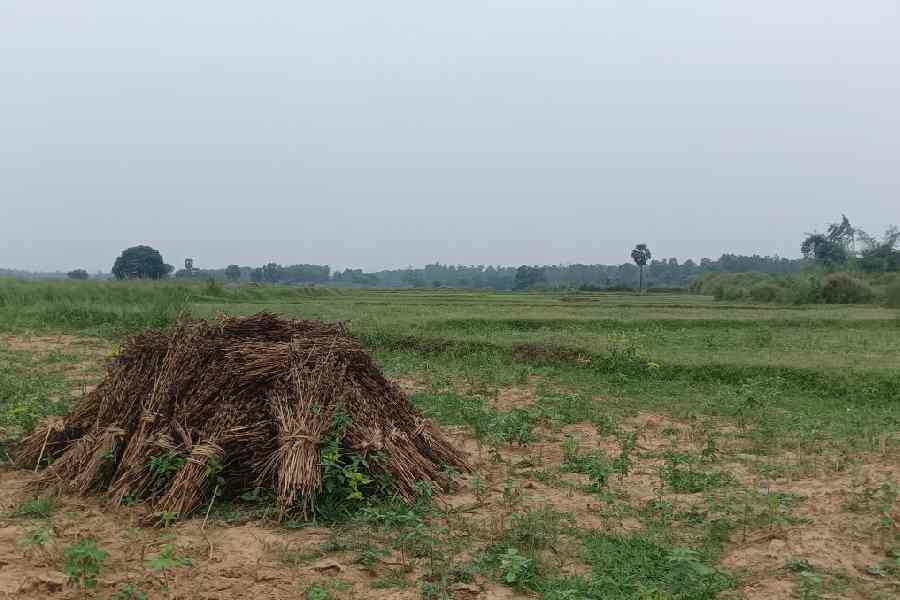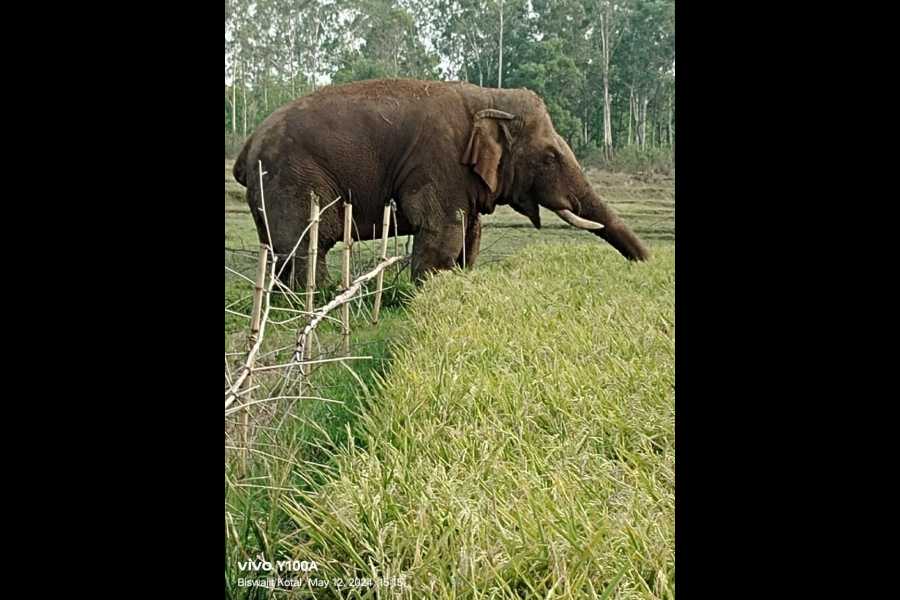Farmers in dozens of villages in agrarian Jhargram, a small western district 180km from Calcutta, are hunting for an answer to a question that has become critical to their livelihood: what crops do elephants not eat?
In this search, Dhirendranath Mahato, a 67-year-old farmer from Jarulia village, has taken a jumbo step — stop cultivation on his seven bighas of fertile land two years ago. He is instead searching for alternative crops that are not part of elephants’ diet.
“My land used to produce excellent paddy. But I can’t afford to feed dozens of elephants every year. A few farmers from my village cultivated sesame and bitter gourd and discovered that these two crops are not favoured by the pachyderms. Now I will try to cultivate those alternative crops,” said Dhirendranath, on his way to the local market to buy some vegetables with his wife, Dhankumari.
Gopal Mahato, who has convinced the elderly farmer to change his agriculture pattern, said the growing raids by elephant herds had forced them to find alternatives. “Sesame and bitter gourd. We found these two crops so far that the elephants do not eat. I cultivated those two crops this year and the elephants did not eat them,” the 45-year-old said.

A board alerts visitors to the elephant corridor. Buddhadeb Bera
With around 21 bighas of agricultural land in the family, Gopal said it became impossible for them to continue with their traditional farming of paddy as elephants would raid their area almost every night as soon as their crops were grown.
Last Saturday, there were 102 elephants in the Jhargram forest division, spreading
into pockets like Lodhashuli, Salbani, Jambani and Gidhni areas. Jhargram is one of
the vulnerable zones of human-elephant conflict in south Bengal.
Researchers on the human-elephant conflict in Jungle Mahal, which includes Jhargram, said the farmers were not only shifting to alternative crops, but some
are slowly converting their land to ponds in an attempt to switch to pisciculture, resulting in a thorough change in the social and economic fabric of the region.
“The increasing number of elephants with a scarcity of food inside the forest has led to a drastic change in the life and livelihood of the people of Jhargram. It is a threat for them as they are not familiar with such alternative farming,” said Nilanjana Das Chatterjee, a professor of geography at Vidyasagar University and a researcher in human-elephant conflict.
According to her, Jungle Mahal farmers are facing a three-fold crisis: Switching to alternative crops in which they are not skilled, lack of infrastructure to market their produce, and most importantly, failing to produce crops like paddy that was essential for their survival.
“The problem is unending. Once the elephants do not get sufficient food from the existing areas, they will move to a new pocket and force the farmers there to follow the same. With this trend, paddy production in the region will face a drastic fall, leading to a crisis in the future,” she added.

A haystack of sesame stockpiled in Jarulia village of Jhargram. Picture by Buddhadeb Bera
As the forest is not as dense as in north Bengal and there is a lack of fruits in the forests, the elephants raid the villages in search of food. A forester said stopping the cultivation of crops that elephants do not eat will lead the animals to raid the houses, which is also a regular phenomenon in the region.
Last December, a wild pachyderm barged into a two-storey mud house in Dhekipura village, 13km away from Jhargram town, dragged out a sleeping 70-year-old woman and trampled her to death. Foresters claimed that the elephant raided the house probably in search of food.
The forest department has taken the initiative to plant fruit trees inside the forest to increase food sources for the animals but it will take time for the trees like jackfruit, elephant apples, or mangoes to grow and bear fruit.
“We will create a few waterholes this time to ensure a water source inside the forest,” said Pankaj Suryawanshi, the divisional forest officer in Jhargram. “There is a long-term plan to improve elephant habitats in dense patches of the forest like Lalgarh in Midnapore by planting fruit trees to ensure a food source for these animals.”
Apart from changing the usual social fabric and agricultural pattern, human-elephant conflict has also claimed lives in Jhargram. In 2022-23, the total number of deaths by elephants in Jhargram was 24, and 17 in 2023-24.
“We are trying to reduce the number of casualties by increasing vigilance and
monitoring of elephant herds. In 2022-23 there were 10,500 elephant days and 24 deaths, while in 2023-24 there were 16,600 elephant days and the deaths were reduced to 17 despite a 60 per cent rise in elephant days,” said Suryawanshi.
Elephant days are counted by the number of elephants staying in a particular zone in a year. If 10 elephants stay in a pocket for 10 days, the elephant days would be 100.
It is not that the movement of the pachyderms is limited to rural pockets, but residents of Jhargram town are also worried as the animals are visible on metal roads.
“Earlier, we used to go for a cup of tea in the evening to nearby dhabas on NH-6. Our friends gave up that recreation a year ago since the elephants became a threat,” said Abirlal Nag, a young state government employee.
In these elections, as all political parties are visiting these elephant-hit pockets seeking votes for their candidates, no one has an answer for those affected.
“This election will come and go like others. No one is there to think about us and to bring a solution to the problem we have been facing,” said Kersab Mahato, a villager from Simli.
“It is the state government that has failed to manage the elephants disrupting human lives. The voters of vast elephant-prone areas are in serious crisis,” said a BJP leader in Jhargram.
State forest minister Birbaha Hansda, who is also the Jhargram MLA, said her department was not leaving any stone unturned to reduce the human-animal conflict. “We will rejuvenate the joint forest management committees after the elections to intensify vigilance over elephant movement. We have a slew of plans to implement to reduce human-elephant conflict.”
Jhargram votes on May 25











